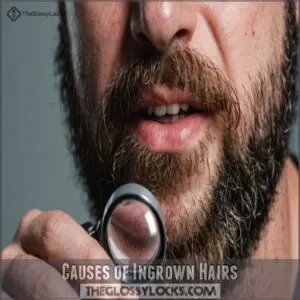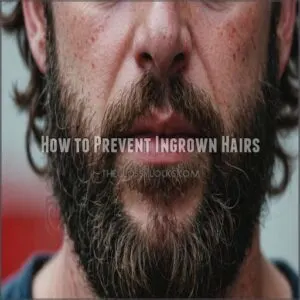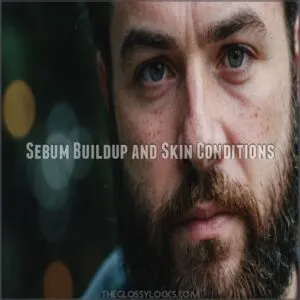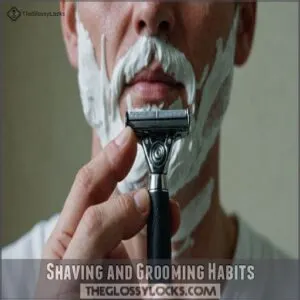This site is supported by our readers. We may earn a commission, at no cost to you, if you purchase through links.
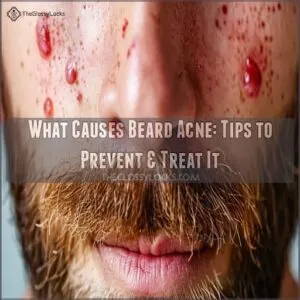 So, what causes beard acne? It’s a common problem, trust me!
So, what causes beard acne? It’s a common problem, trust me!
Often, it’s a combination of things: poor hygiene—think not washing your beard regularly—and ingrown hairs.
Sometimes, it’s simply too much oil (sebum) building up, clogging pores.
Bacterial infections can also play a part, making things worse.
Irritated skin from shaving too closely is another culprit.
Basically, your beard’s environment needs some TLC.
Think of it like this: a clean, healthy beard is a happy beard!
Want to know how to conquer this? We’ve got some seriously helpful tips coming up…
Table Of Contents
- Key Takeaways
- Poor Hygiene Habits
- Ingrown Hairs and Folliculitis
- Sebum Buildup and Skin Conditions
- Shaving and Grooming Habits
- Other Contributing Factors
- Frequently Asked Questions (FAQs)
- What causes beard acne?
- Why are my beard pimples so bad?
- Can you get acne if you have a beard?
- Does Beard oil cause acne?
- Can beard acne cause itching?
- Why does my beard look like a pimple?
- How do I get rid of beard acne?
- Is it normal to have beard acne?
- Why does my boyfriends facial hair make me break out?
- Does acne stop beard growth?
- Can diet impact the occurrence of beard acne?
- Do stress levels contribute to beard acne?
- Are certain fabrics causing beard acne?
- Does pollution play a role in beard acne?
- How does skincare product choice affect acne?
- Conclusion
Key Takeaways
- Keep your beard clean and moisturized daily to prevent bacteria buildup and reduce the risk of beard acne.
- Use proper shaving techniques and tools to avoid ingrown hairs and inflammation around hair follicles.
- Exfoliate regularly to remove dead skin cells and control excess oil, which can clog pores and cause breakouts.
- When suffering from beard acne, consider incorporating products with soothing ingredients like fragrance-free beard oil. Manage your skincare routine with non-comedogenic products that suit sensitive skin to maintain a healthy beard and skin.
Poor Hygiene Habits
Keeping your beard clean and moisturized is like maintaining a car—you can’t expect it to run smoothly if you neglect basic care.
Skipping daily washes, forgetting to exfoliate, or ignoring hydration can turn your facial masterpiece into a breakout disaster.
Not Washing The Beard Daily
Forgetting to wash your beard daily is like skipping out on walking the dog—it won’t end well!
Without regular care, beard odor can sneak up, and bacteria buildup might cause clogged pores and follicle irritation.
Keep skin irritation at bay by making beard wash a part of your daily routine.
That way, beard care and skin hygiene stay on point.
Not Exfoliating The Skin
Neglecting skin exfoliation in your beard care routine can lead to beard acne.
Imagine this: dead skin cell build-up, increased oil production, and even worse, clogged pores.
Here’s how you tackle it:
- Exfoliate: Scrub away those dead skin cells.
- Prevent: Reduce bacterial growth and follicle inflammation.
- Balance: Control sebum to avoid ingrown hairs.
Not Hydrating The Skin
When you skip hydrating your skin, it’s like asking for beard acne.
Dry skin can lead to pesky irritations, especially in winter.
Using a high-quality hydrating beard oil product, such as one from Everysimply’s beard care line, can help to tackle this issue.
To tackle this, use beard oil or a soothing beard
Sharing Personal Grooming Tools
Imagine this: you grab your buddy’s beard trimmer and zap—instant bacteria spread!
Sharing tools might seem harmless, but it boosts hygiene risks and shortens tool lifespan.
Investing in a reputable beard care kit for beard health can help with skin hydration and maintaining a healthy beard.
Fungal infections love the chance to jump in, causing beard acne and that dreaded beard itch.
Stick to your own grooming
Not Cleaning Personal Grooming Tools
Sharing your tools? Big no-no!
Dirty trimmers are breeding grounds for bacteria buildup, leading to beard acne and ingrown hairs.
Think of your grooming tools like your toothbrush – you wouldn’t share that, right?
Regular cleaning is key for Grooming Tool Hygiene.
Clean Tools Matter; a quick wipe-down after each use and a deep clean weekly prevents nasty surprises.
Proper Shaving Tool Maintenance keeps those pesky beard itches at bay.
Ingrown Hairs and Folliculitis
Ingrown hairs are those pesky little curls that decide to grow back into your skin, causing red bumps that aren’t exactly the look you’re going for.
Folliculitis, on the other hand, brings inflammation and discomfort to hair follicles, making your beard feel like a battleground, but with a good routine, you can declare victory and keep your beard looking sharp.
Ingrown Hairs From Curly Hair Furling Inside Skin
Ever had a curly beard hair rebel and curl back into your skin? It’s a hairy situation! Ingrown hairs can cause beard acne and itchiness, but there’s a fix. Try these tips:
- Proper trimming: Trim regularly to avoid tight curls piercing the skin.
- Use beard oil benefits: Soften hair and boost follicle health.
- Mind your hair texture: Different textures need different care.
Folliculitis and Inflammation Around Hair Follicles
Folliculitis, a pesky problem where hair follicles get inflamed, often teams up with ingrown hairs to cause beard acne.
It shows up as those annoying red bumps or razor bumps.
To tackle this, keep your beard clean, moisturize regularly, and avoid tight grooming techniques.
If symptoms worsen, consider seeing a dermatologist for effective folliculitis treatment and prevention tips.
Causes of Ingrown Hairs
Imagine your beard as a wild garden; curly beard hair texture can sometimes loop back into the skin.
This happens because of improper shaving techniques or ignoring the hair growth direction, causing pesky ingrown hairs.
These can irritate the skin, leading to folliculitis, razor bumps, and, eventually, beard acne.
Understanding these causes helps you tackle them head-on.
How to Prevent Ingrown Hairs
When ingrown hairs cause beard acne, tackle them with simple steps.
Embrace proper shaving techniques, and use sharp blades or electric trimmers.
Regularly exfoliate with salicylic acid to prevent hairs curling inward and wreaking havoc.
Maintain a moisturizing routine to keep skin supple.
Master beard trimming tips, and always shave in the hair growth direction for less irritation and more confidence.
Sebum Buildup and Skin Conditions
You’re not alone if you’ve encountered pesky beard acne, often caused by sebum buildup at the base of hair follicles and sebaceous glands working overtime to keep those hair strands healthy.
Add in some common skin conditions like dermatitis, and it’s like your face has decided to throw a party you didn’t RSVP to—thankfully, there are ways to manage this.
Sebum Buildup at Follicle and Hair Shaft Base
Too much sebum buildup around your hair follicles is a common culprit behind beard acne.
This excess oil, combined with dead skin cells, easily clogs pores, leading to those pesky pimples.
Regularly washing your beard with a gentle cleanser, such as a specialized beard wash product, helps.
Using a beard oil, believe it or not, can actually help
Sebaceous Glands Overworking to Nourish Hair Strands
Sebaceous glands can go into overdrive to hydrate facial hair, leading to beard acne.
It’s like having co-workers who just can’t stop doing your job.
Manage this with smart choices:
- Beard oil benefits include nourishment without clogging pores.
- Supporting a healthy scalp with a balanced diet rich in protein-packed foods for hair growth can also promote overall skin health.
Skin Conditions That Contribute to Beard Acne
Ever feel like your skin’s plotting against your smooth beard dreams?
With beard acne, conditions like Seborrheic Dermatitis, Eczema, or even Rosacea might be the culprits.
These skin conditions can cause inflammation and clogged pores, leading to acne-prone skin.
Don’t fret, identifying these issues under your facial hair can help you manage those pesky bumps and regain some control over your skin’s rebellion.
How to Manage Skin Conditions
Managing skin conditions like beard acne means finding the right balance.
Embrace a skincare routine that hydrates and controls sebum buildup.
Choose products for sensitive skin and consider home remedies.
If things don’t improve, a dermatologist’s advice is gold.
It’s not just about habits—lifestyle changes matter too.
Tackle those cheeky beard bacteria with patience and care, and you’ll be on track!
Shaving and Grooming Habits
If you’re finding pesky beard acne popping up after shaving, your grooming habits might be the culprit.
Using the right tools and techniques can make all the difference, helping to keep your skin smooth and irritation-free while preventing unwanted breakouts.
Shaving Close to Skin Causes Inflammation Around Hair Follicles
Shaving too close can feel like a smooth move, but it’s actually setting your skin up for trouble.
Pushing those razors tight leads to razor burn, ingrown hairs, and follicle irritation faster than you can say "ouch!"
Your skin’s sensitivity doesn’t stand a chance when inflammation jumps in, turning your facial hair grooming session into an acne battlefield.
How to Shave Properly to Prevent Acne
A smooth shave isn’t just about looking sharp; it’s about dodging those pesky beard acne bumps.
Follow these shaving tips to prevent clogged pores and inflammation, similar to how dermatologist-recommended treatments for severe acne can help clear skin: Follow these shaving tips to keep your skin clear:
- Apply pre-shave oil to soften hair
- Shave in the direction of hair growth to avoid irritation
- Use a sharp blade for clean cuts
- Rinse with lukewarm water
- Soothe skin with an aftershave balm
Using The Right Grooming Tools
With beard acne a real pain, choosing the right tools is key.
Invest in a quality beard brush—boar bristle is great—for gentle exfoliation.
Learn proper shaving techniques; avoid harsh blades.
Consider the tool material; stainless steel is usually best.
Regular oil application keeps your skin and beard happy, reducing irritation.
Remember, good beard grooming is a game-changer!
How to Maintain Clean Grooming Tools
Let’s face it, grooming tools mightn’t clean themselves.
To keep them spotless and acne-free, here’s a quick checklist:
- Clean frequently: Make it easy by doing it after each use.
- Sterilize regularly: Disinfectant wipes work wonders.
- Store properly: Keep them dry to avoid rust.
- Replace timely: Follow a replacement schedule to maintain effective facial hair care.
Other Contributing Factors
Even with perfect grooming, other culprits like bacteria lurking in your pores and inflammation around hair follicles can still trigger beard acne.
Don’t worry, though—by keeping these factors in check, you’ll be well on your way to smoother, clearer skin.
Bacterial Infection in Pores
Imagine this: you’re careful with your grooming routine, yet pesky acne clings on.
It might be bacteria sneaking into your pores, causing flair-ups.
Try antibacterial products and consistent pore cleansing to keep those critters at bay.
| Bacteria Types | Hygiene Practices | Antibacterial Products |
|---|---|---|
| P. acnes | Daily washing | Benzoyl peroxide |
| Staphylococcus | Avoid tool sharing | Salicylic acid |
| Streptococcus | Regular exfoliation | Azelaic acid |
Inflammation Around Hair Follicles
Inflammation around hair follicles can turn your beard into a battleground where acne often wins.
Folliculitis can sneak up like an uninvited guest, causing red, angry bumps.
Don’t let ingrown hairs and razor burn join the party; they only make it worse.
Use beard oils and refine your shaving technique to soothe the skin, giving inflammation the boot.
How to Prevent Bacterial Infection
Although it might seem like overkill, keeping those grooming tools squeaky clean is key to stopping bacterial infections in their tracks.
Using an antibacterial beard wash can give you an extra layer of protection against germs.
Wash your beard daily with antibacterial products and swap out pillowcases often to prevent bacterial growth.
Don’t forget your secret weapons: beard
How to Reduce Inflammation
To soothe beard inflammation, consider small lifestyle changes.
Eating an anti-inflammatory diet can help calm your skin.
Manage stress; perhaps try yoga, so stress-beast doesn’t rear its ugly head.
Use topical treatments like salicylic acid and beard oil to reduce redness.
These steps won’t only aid acne prevention, but they’ll also boost your overall skin health.
- Anti-inflammatory diet
- Stress management
- Topical treatments
Frequently Asked Questions (FAQs)
What causes beard acne?
Imagine your beard as a magnet for dirt and bacteria, luring in breakouts.
Shaving with the wrong product can lead to shaving cream for ingrown hairs and exacerbate skin issues. Skipping daily cleanses or using harsh products can stir up trouble, while ingrown hairs from shaving add extra woes.
Keep it clean, and you’ll shine!
Why are my beard pimples so bad?
Your beard pimples might be causing such distress due to dirt, oil buildup, bacteria, or even ingrown hairs.
Keeping your beard clean, exfoliating regularly, and using non-comedogenic products can help tame those pesky bumps.
Can you get acne if you have a beard?
Growing a beard can be like planting a garden—if you don’t tend it, unwanted visitors might sprout.
Acne can happen with a beard due to trapped bacteria, dead skin cells, and natural oils.
Does Beard oil cause acne?
Beard oil can sometimes cause acne if it’s too heavy or clogs pores, especially if it’s not non-comedogenic.
Opt for lighter oils and wash your beard regularly to keep your skin clear and fresh.
Can beard acne cause itching?
Imagine a prickly cactus; that’s what beard acne can feel like on your face.
Yes, it can cause itching due to inflammation and trapped bacteria under the skin.
Keep your beard clean to reduce itchiness.
Why does my beard look like a pimple?
It’s probably a pimple under your beard!
Dirt, bacteria, or ingrown hairs can cause this.
Try washing your beard daily and using a gentle cleanser.
A good beard oil can help too.
How do I get rid of beard acne?
Dave once tamed his beard acne by exfoliating gently with salicylic acid twice weekly and moisturizing daily.
Try washing your beard twice a day, using beard oil, and trimming it properly.
Don’t forget to clean your trimmers!
Is it normal to have beard acne?
Yep, it’s normal to get a few pesky pimples hiding in your beard.
Dirt, oils, and dead skin can sneak in, causing breakouts.
Keep your beard clean and hydrated to help banish those unwanted guests.
Why does my boyfriends facial hair make me break out?
Ever wondered why your boyfriend’s facial hair triggers breakouts?
His beard might trap bacteria and oils that can transfer to your skin, leading to acne.
Encourage clean habits, and who knows, a grooming kit could be your new best friend!
Does acne stop beard growth?
Acne itself doesn’t usually stop beard growth, but severe cases can affect it.
Inflammation and scarring from untreated acne might harm hair follicles, slowing growth.
Keeping your skin healthy and acne under control supports beard growth.
Can diet impact the occurrence of beard acne?
You might be surprised to learn that your diet can indeed impact beard acne.
Eating lots of greasy or sugary foods can increase oil production, leading to breakouts.
So, managing your diet may help keep beard acne at bay.
Do stress levels contribute to beard acne?
Underneath your beard, stress can contribute to acne by triggering hormonal changes that boost oil production.
Why? Because stress revs up sebum, the oil loving to clog pores and invite unwelcome visitors – like acne.
Are certain fabrics causing beard acne?
Rough fabrics can irritate your skin, trapping dirt and oil. This can definitely lead to breakouts. Try softer materials like cotton against your face; your skin will thank you!
Does pollution play a role in beard acne?
Pollution contributes to beard acne by clogging pores with dirt and grime, leading to breakouts.
Picture your beard as a sponge; it absorbs airborne particles that mix with oil and sweat, fueling pesky pimples.
How does skincare product choice affect acne?
Picking the right skincare products can make a world of difference.
Opt for gentle, non-comedogenic items to prevent clogging pores.
Your skin mightn’t appreciate those harsh chemicals, so go for soothing, sensitive-skin-friendly options.
Conclusion
Beard acne—because who doesn’t love juggling hygiene, ingrown hairs, excess oil, and a shaving routine every morning?
By now, you’ve got a playbook to tackle what causes beard acne.
Embrace washing that beard like it’s part of your dating profile, exfoliate like you’re in an infomercial, and treat those ingrown hairs like plot twists.
Find the right products that make you smile, not grimace, and wave goodbye to those pesky bumps.
Your beard will thank you!
- https://www.koat.com/news/some-beards-as-dirty-as-toilets/32675046
- https://www.iflscience.com/health-and-medicine/your-beard-does-not-contain-more-poo-toilet/
- https://www.ncbi.nlm.nih.gov/pubmed/24746610
- https://www.yalemedicine.org/news/beard-mustache-skin-problems
- https://www.mayoclinic.org/diseases-conditions/folliculitis/symptoms-causes/syc-20361634




